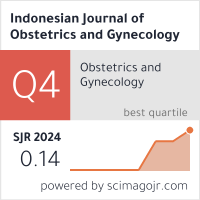The Age as a Risk Factor for Advanced Stage in Cervical Cancer Patients at RSUPN Cipto Mangunkusumo 2019-2022: A Retrospective Multivariate Study
Abstract
Abstract
Introduction: In 2020, cervical cancer ranked as the fourth most common cancer in women globally, with an incidence of 604,000 cases. In Indonesia, cervical cancer holds the second position among the most prevalent cancers in women. This study aims to evaluate the relationship between age and the occurrence of advanced-stage cervical cancer as a step towards effective prevention, early detection, and management. Methods: This research adopts a retrospective study design based on the Cancer Registration database of RSUPN Cipto Mangunkusumo, focusing on cervical cancer patients from 2019 to 2022. Multivariate analysis was conducted with age as the primary independent variable, considering parity and employment status in the analysis. The FIGO classification of cervical cancer stages was used to categorize patients into early and advanced stages. Results: Out of 512 cervical cancer cases, 492 were included in this study. The distribution of cervical cancer stages and the age distribution of patients is depicted in Figure 1 and Figure 2. The analysis of the relationship between cervical cancer stage, age, parity, and employment status is presented in Table 2. The association between age and cervical cancer stage is statistically significant (p<0.05) with an odds ratio of 2.13, particularly in individuals aged >54 years. Conclusion: Age over 54 years is a significant risk factor for advanced-stage cervical cancer. Although there is no significant association with parity and employment history, these findings support preventive and early detection efforts in the older population. Increased screening programs and education are expected to reduce cases of advanced-stage cervical cancer in the future.
Downloads
Copyright (c) 2025 Indonesian Journal of Obstetrics and Gynecology

This work is licensed under a Creative Commons Attribution-NonCommercial-ShareAlike 4.0 International License.













